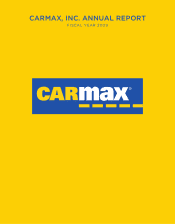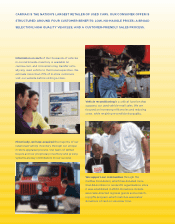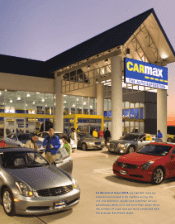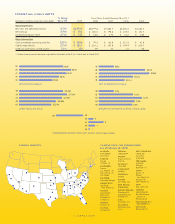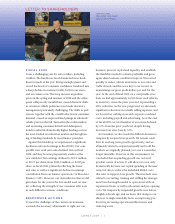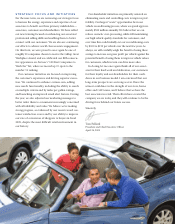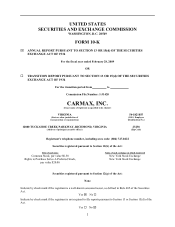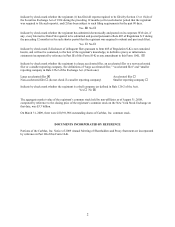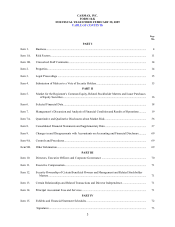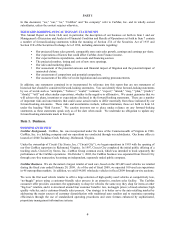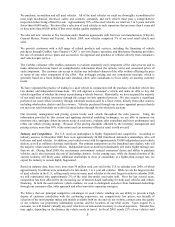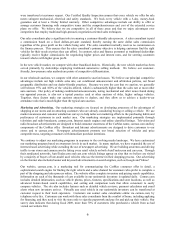CarMax 2009 Annual Report Download - page 5
Download and view the complete annual report
Please find page 5 of the 2009 CarMax annual report below. You can navigate through the pages in the report by either clicking on the pages listed below, or by using the keyword search tool below to find specific information within the annual report.
FISCAL 2009
It was a challenging year for auto retailers, including
CarMax. The hurdles we faced dominated news head-
lines for much of the year. Rising unemployment and
record low levels of consumer confidence translated into
a sharp decline in customer traffic, both in our stores
and on carmax.com. The steep increase in gasoline
prices in the spring and summer of 2008 and the subse-
quent collapse only months later caused dramatic shifts
in consumer vehicle preferences and made inventory
management particularly challenging. The shifts in pref-
erences, together with the overall reduction in consumer
demand, caused an unprecedented plunge in wholesale
vehicle prices in the fall. Turmoil in the credit markets
and worsening consumer default and delinquency
trends resulted in dramatically higher funding costs in
the asset-backed securitization market and the tighten-
ing of lending standards by most finance providers.
Against this backdrop, we experienced a significant
decline in sales and earnings in fiscal 2009. Our com-
parable store used unit sales declined 16% in fiscal
2009, and they became progressively weaker as the
year unfolded. Net earnings declined to $59.2 million,
or $0.27 per share, from $182.0 million, or $0.83 per
share, in fiscal 2008, primarily reflecting the lower
unit sales as well as a significant decline in earnings
contribution from our finance operation, CarMax Auto
Finance (CAF). However, our data indicates that we did
gain share for the year in the late-model used car mar-
ket, reflecting the strength of our consumer offer even
in such difficult economic conditions.
RESPONSIVE ACTIONS
To meet the challenges of the current environment,
we made the necessary adjustments to right-size our
CARMAX 2009 | 3
TOM FOLLIARD
PRESIDENT AND CHIEF
EXECUTIVE OFFICER
LETTER TO SHAREHOLDERS
business, preserve capital and liquidity, and establish
the flexibility needed to remain profitable and grow
again when business conditions improve. We reacted
quickly to reduce vehicle inventories as our sales and
traffic slowed, and this was a key to our success in
maintaining our gross profit dollars per unit for the
year. At the end of fiscal 2009, on a comparable store
basis we had approximately 16,500 fewer used vehicles
in inventory versus the prior year end, representing a
28% reduction. As the year progressed, we also made
significant reductions in variable selling expenses, and
we focused on curbing store and corporate overhead
costs, including payroll and advertising. As of the end
of fiscal 2009 our total number of associates declined
by 17% from the prior year level, despite having
increased our store base by 12%.
In December, we also made the difficult decision to
temporarily suspend store growth. We remain confi-
dent in our long-term growth opportunity, and we
ultimately intend to expand nationally and to all the
markets we originally planned, just over a somewhat
longer timetable. However, in this environment, we
concluded that suspending growth was our most
prudent course of action. It will allow us to not only
dramatically decrease our capital spending in the near
term, but also to reduce the imbedded SG&A costs
that exist to support store growth. These include costs
related to recruiting, training and staffing the manage-
ment bench strength needed to open stores with an
experienced team, as well as relocation and pre-opening
costs. We temporarily suspended growth once before,
roughly a decade ago, and we know that doing so can
allow us to single-mindedly focus on improving pro-
ductivity, increasing operational effectiveness and
reducing waste.

